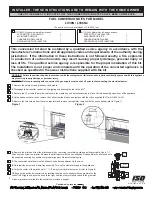
54
HISTOGRAM MODE
–
EXPOSURE
The histogram provides a graph that indicates the total number of pixels at each
brightness level, with brightnesses going from black on the left to white on the
right. It is a valuable tool for evaluating captures. A well-exposed shot usually has
a full range of levels, while under- and overexposed shots tend to show levels con-
centrated at the left or right part of the scale, respectively. The histogram is only
an indicator that should be interpreted – there are several situations in which a
‘bad’ histogram will match an exposure that could be perfect for the intended ef-
fect (and vice-versa). Look at the histogram examples and the explanations below:
EVEN EXPOSURE
A histogram display that is spread across the full range indicates a likely good ex-
posure. There may still be a few pixels at the extremes, indicating a few spectral
highlights and saturated shadows, but this is often normal in a good exposure.
UNDEREXPOSURE
A histogram display that is concentrated on the left with few pixels elsewhere indi-
cates a likely underexposure. Many details will be lost in the shadows.
OVEREXPOSURE
A histogram display that is concentrated on the right with few pixels elsewhere
indicates a likely overexposure. Many details will be lost in the highlights.
BROWSING
In
Browse
mode use the front scroll
wheel (or left or right arrows on
the navigator button) to browse cap-
tures in a folder. Zoom out to Folder
View if you want to select another
folder to browse.
Histogram and Full details
Combined Histogram
Histogram mode
Even exposure
Underexposure
Overexposure
HISTOGRAM TYPES
There are three types of histogram representation available:
Histogram and Full details
,
Combined histogram
and
Histogram
mode.
In Histogram and Full details mode,
you can read a list of camera set-
tings, plus see the histogram and, in
the background, a darkened preview
of the image. The setting details are
stored with the capture file, so you
can also refer to them in Phocus and
other applications.
In Combined Histogram mode, the
RBG channels are represented to
show individual distribution against
a luminosity histogram.
In Histogram mode, the individual
RBG channels are represented to
show a comparitive display.
Summary of Contents for H5D
Page 1: ...1 USER MANUAL v11 ...
Page 2: ...2 INTRODUCTION ...
Page 19: ...19 Photo Dmitry Ageev Hasselblad Masters GENERAL ...
Page 31: ...31 Photo Roman Jehanno Hasselblad Masters LENSES FOCUS MODES ...
Page 42: ...42 Photo Martin Schubert Hasselblad Masters EXPOSURE CONTROL ...
Page 48: ...48 Photo Hengki Koentjoro Hasselblad Masters NAVIGATING THE MENUS ...
Page 52: ...52 Photo Dmitry Ageev Hasselblad Masters PREVIEWS BROWSING ...
Page 56: ...56 SENSOR UNIT SETTINGS Photo Hengki Koentjoro Hasselblad Masters ...
Page 71: ...71 Photo Bara Prasilova Hasselblad Masters GRIP MENU SETTINGS ...
Page 87: ...87 PROFILES Photo Rafal Maleszyk Hasselblad Masters ...
Page 90: ...90 Photo Bara Prasilova Hasselblad Masters FLASH STROBE ...
Page 94: ...94 HM 16 32 FILM MAGAZINE OPTIONAL ACCESSORY Photo Hengki Koentjoro Hasselblad Masters ...
Page 102: ...102 ACCESSORIES Photo Roman Jehanno Hasselblad Masters ...
Page 108: ...108 APPENDIX Photo Bryn Griffiths Hasselblad Masters ...
Page 118: ...118 H5D UM 1L v11 2015 Copyright 2015 Victor Hasselblad AB ...
















































